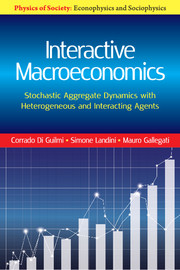Book contents
- Frontmatter
- Dedication
- Contents
- Figures
- Tables
- Preface
- 1 Introduction
- Part I Methodological Notes and Tools
- Part II Applications to HIA Based Models
- Part III Conclusions
- Part IV Appendices and Complements
- Appendix A Complements to Chapter 3
- Appendix B Solving the ME to Solve the ABM
- Appendix C Specifying Transition Rates
- References
- Index
Appendix C - Specifying Transition Rates
from Part IV - Appendices and Complements
Published online by Cambridge University Press: 23 July 2017
- Frontmatter
- Dedication
- Contents
- Figures
- Tables
- Preface
- 1 Introduction
- Part I Methodological Notes and Tools
- Part II Applications to HIA Based Models
- Part III Conclusions
- Part IV Appendices and Complements
- Appendix A Complements to Chapter 3
- Appendix B Solving the ME to Solve the ABM
- Appendix C Specifying Transition Rates
- References
- Index
Summary
Chapter 3 and Appendix B present a detailed description of the ME while developing a solution method. Remarks B.1, B.3 and B.4 give evidence that the most important issue in developing and solving the ME is the specification of the transition rates. This is due to two reasons exposed in Appendix B:
• Section B.2: the transition rates provide a micro-foundation to the mean-field interaction;
• Section B.7.2: the equations that solve the ME depend on the transition rates.
Nevertheless, as relevant as it is, at present, there is no precise set of rules to follow in specifying the transition rates. Sometimes their functional forms follow from theoretical deductions while, in other cases, they come from repeated experimental inductions: it depends on the phenomenon under scrutiny. It therefore seems there is some degree of subjectivity and arbitrariness with this issue: the following sections give proof that, at least under given circumstances, a unified and generic methodology is possible.
More precisely, in the ME approach to the ABM solution, that is, when an ABM is the DGP of an extensive, transferable and conservative aggregate quantity X of interest, this appendix provides a generic methodology to specify transition rates of the ME under the nearest-neighbourhood hypothesis, so providing a structural and phenomenological micro-foundation of the mean-field interaction involved in the ME for W (X (t),t). The following sections do not provide a general method to specify transition rates for any kind of ME; nevertheless, the methodology developed here can be considered as an initial route: chapters of Part II provide applications.
The structure of this appendix is as follows. Section C.1 defines migrations of agents on a state space as the main causes of the movements of a stochastic process on its support. Section C.2 introduces the two perspectives in the interpretation of transition rates. Section C.3 provides a unified methodology to combine the structural interpretation of transition rates with a phenomenological interpretation. Section C.4 provides some comments on the interpretation of the unified method and Section C.5 describes how to implement the phenomenological interpretation into the structural description of transition rates. Section C.6 ends this appendix with comments.
- Type
- Chapter
- Information
- Interactive MacroeconomicsStochastic Aggregate Dynamics with Heterogeneous and Interacting Agents, pp. 242 - 272Publisher: Cambridge University PressPrint publication year: 2016



